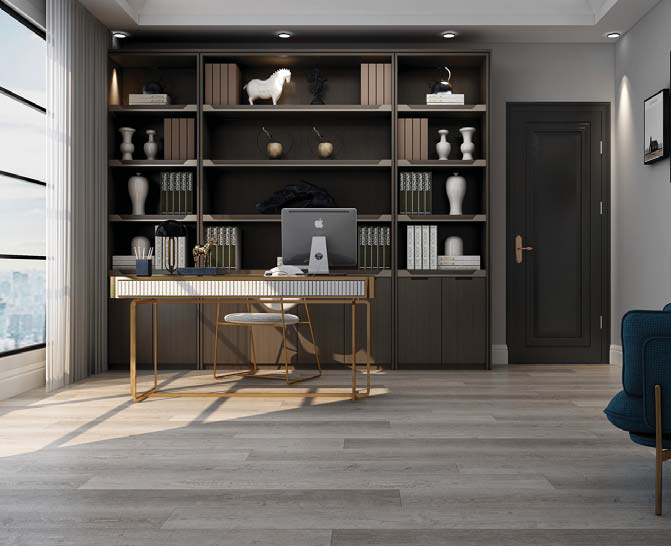Learn about the different types of flooring and which might be the best choice for your application.
A recent survey of residential real estate listings revealed that the most commonly used phrase was ” hardwood throughout.” Clearly, realtors have discovered that wood floors throughout a home are huge selling feature ( despite the fact that the Appraisal Institute of Canada reports an ROI of only 50 to 75 percent for new hardwood floors). And for a kitchen, tile and hardwood are certainly the most desirable. But these days, there are lots of other options to keep the costs in line and the returns high, including vinyl, tile, and hardwood. When you are trying to choose , keep in mind that the flooring has to tie in with everything else–the cabinets, the countertops, and the rest of the house. If the kitchen is part of an open-concept floor plan, then you need to consider how the flooring you choose for the kitchen will transition into the other spaces. Using only one type of flooring throughout ( hardwood, for example ) makes the space feel bigger and more open. And if you are doing a complete kitchen reno, make sure that the flooring goes down before the cabinets and that it stretches from wall to wall. That way, if you need to make a change or move a cabinet you’ll have the flooring in the newly opened space.
Tile
Tile is a great choice for kitchen floors. It comes in a huge variety of styles and colours, is essentially waterproof and is easy to clean. As with backsplash tiles, plain floor tiles can be laid in diffferent designs ( herringbone, brick, etc. ) and may also incorportate decorative accent tiles amongst the solid ones. The only drawbacks to tile are that it can be unforgiving when a plate or a glass is dropped on it, and some people find standing on it for long periods to be hard on the backs and feet.
There are essentially three types of tile: porcelain, ceramic and natural stone. My favourite choice for kitchen floors is porcelain tie. I use it in about 90 percent of the kitchens I remodel. The great thing about quality porcelain is that it is the same colour throughout–if it chips, it’s not as noticeable as a damaged ceramic tile, which ususally has a coloured glaze covering its surface. But be careful when choosing porcelain tile. More and more manufacturers are selling porcelain tile that uses coloured glazes over white porcelain, which elimates this advantage. That said, all porcelain tile is very durable. It is essentially the same material as standard ceramic tile but denser, making it more resistant to cracking and staining. So while porcelain is a bit more expensive then ceramic, it holds up better in the long run. It’s worth the investment, as far as I’m concerned.
Natural stones, like slate, marble and granite, are available as floor tiles. Slate has become so inexpensive that, in my opinion, it is being overused. As a result, while it is durable, slate doesn’t really add the air of luxury that it once did. Natural slate, which has an uneven surface texture and a variegated colour, lends a very rustic look to a space. ( And because the tile depth is uneven, your grout lines might end up being uneven as well. ). Polished slate offers a more sophisticated, contemporary look. Marble and granite are also available as floor tiles–and in a wide variety of colours and some very attractive mosaic patterns. But when opting for granite and marble floor tiles, use caution. The inexpensive marble and granite types used for floor tiles can contain veins and inconsistencies that lead to cracking. This is of particular concern with larger tiles and when tiling large areas. And all natural stone floors need to be sealed immediately after they are installed, and again once or twice a year.
Hardwood
Years ago, hardwood was thought to be an impratical choice for kitchens. People were concerned with potential water damage. But home much water really ends up on a kitchen floor? And who doesn’t clean up the occasional spill right away! The prefinished hardwood flooring available today is well sealed, durable and good-looking, making it perfectly suitable for kitchen use. But if you are really worried about moisture, you can opt for an engineered hardwood. Made with layers of wood covered witha. wood veneer, engineered hardwood withstands changing mositure levels without expanding, contracting or twisiting. And like solid hardwood, it can be resfinished eventually, if neccessary, although not as many times as solid hardwood.
Putting hardwood in a kitchen has the advantage of minimizing transitions from room to room if the rest of the house features hardwood as well ( that is, as long as you choose matching hardwood ). This is especially useful in an open-concept floor plan.
Carpet Tile
Laminate flooring is made by applying what is essentially a photograph of wood, stone or tile over planks of particleboard, then covering this with a clear, durable coating. Laminate flooring is moderately priced and easy to install. It also is available in a wide range of looks–in just about any colour or grain of wood that you can imagine, as well as in stone and tile options. But the greatest problem with laminates is that if the top layer gets chipped or scuffed, the damage is really noticeable–and there is no way to fix it. Another drawback of laminates in a kitchen is that if you do have a leak, the particleboard swells very quickly, buckling the floor. Your only option then is to pull the planks out and replace them. For those reasons, I have never used tile-look laminates and have choosen wood-look laminates for a kitchen only if I am matching them with flooring in another room.
Glue-down sheet vinyl used to be a common type of flooring for kitchens. May liked the cushionly feel. And it is waterproof and easy to clean. But sheet vinyl will scuff and scratch, and because it is so pliable, it will show any imperfection from the surface beneath it. You need to put sheet vinyl down over a new subfloor or use an epoxy skimming product over the existing floor to even everything out.
For those reasons, my preference, when going with a vinyl floor for the kitchen, is a product called Rigidcore Plus Vinyl Collection. It’s a solid vinyl plank flooring. The planks come four feet long and seven inches wide and can be cut easily with a utility knife. A floor adhesive is trowelled over the existing floor, and once the planks are in place, this adhesive cures completely, so there is no movement in the floor. And unlike vinyl sheets or tiles, the colour of the vinyl is not limited to a top layer but goes right through the vinyl. This makes plank vinyl flooring exceptionally durable–and any nicks or cuts easily escape notice ( which is why you often find these kinds of floors in high-end hotels and stores ). But the best thing about vinyl plank flooring is that it can go directly over concrete slabs–making it an ideal product for basement apartments, where you want the slimmest floor possible so that you lose as little ceiling height as possible. And like all vinyl, Rigidcore Plus Vinyl Collection comes in an extensive variety of colours and patterns. The price point for this type of flooring is mid-range, and installation is easy to do yourself.
Contact us today for a free estimate at 604-761-1605 or info@priorityoneflooring.com

